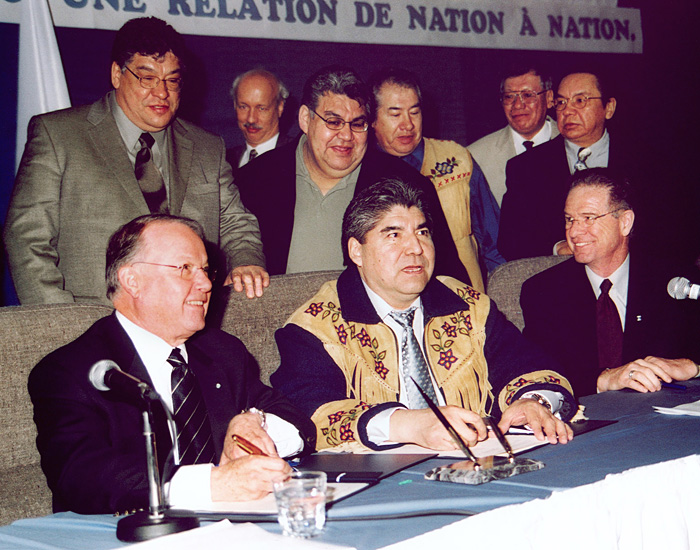1997-… – Renewed Growth
In 1997, the North American electricity market opened its doors to competition. Hydro-Québec obtained a power marketer licence for the U.S. wholesale market. Since the company essentially produces hydropower and can depend on its reservoirs, it was able to capitalize on new business opportunities in the northeastern U.S. through short-term buying and selling. The organization adapted well to the new deregulated environment, protecting the vested interests of Québec consumers and enriching Québec society. To meet growing demand for electricity in Québec, Hydro-Québec continued to develop the province’s economically viable hydroelectric potential. From this new context emerged a renewed corporate structure in which Hydro-Québec’s operations were grouped into four divisions.
Furthermore, since 1999, the company’s activities have been certified through the ISO 14001 process, which confirms that its environmental management system is based on internationally recognized standards.
1997
Wholesale electricity market opened up
To reciprocate with other North American energy producers, Hydro-Québec opened its transmission system and wholesale electricity market to competition. A new division, Hydro-Québec TransÉnergie, was created to provide non-discriminatory access to Québec’s transmission grid. The U.S. Federal Energy Regulatory Commission (FERC) granted a subsidiary of Hydro-Québec, Hydro-Québec Energy Services (U.S.), a licence to sell wholesale electricity at market prices. This authorization enabled Hydro-Québec to expand its market, capitalize on business opportunities outside Québec, and contribute even more to Quebecers’ collective prosperity.
Strategic partnership
Spurred by the energy convergence sweeping North American markets, Hydro-Québec acquired a substantial share of Noverco—a holding company that controls natural gas distributor Gaz Métropolitain—with a view to participating in the growth of power transmission and natural gas distribution in northeastern North America.
Top of page1998
An unprecedented storm
In January, an ice storm of unprecedented severity damaged a significant part of Hydro-Québec’s transmission and distribution system. Some customers were without electricity for four weeks. Nonetheless, over 97% of Quebecers said they were satisfied with the way Hydro-Québec handled the situation. To improve the reliability of electricity supply for all its customers, the company carried out major work to reinforce its transmission system, particularly in areas with a high risk of icing.
To learn more about the events of January 1998, visit our virtual exhibition Icy January.
Slide show
The following slide show contains images from the year 1998
2001
Corporate renewal
After the Act respecting the Régie de l’énergie was amended in 2000, Hydro-Québec unbundled the operations of the business units in charge of generation, transmission and distribution. Two new divisions, Hydro-Québec Production and Hydro-Québec Distribution, joined Hydro-Québec’s TransÉnergie division, which had been created in 1997. Hydro-Québec Équipement (construction division) was established in June 2002.
Hydro-Québec Distribution is responsible for supplying electricity to Québec markets. To protect the assets acquired through nationalization, the law established a "heritage pool" whereby Hydro-Québec Production is required to supply Hydro-Québec Distribution with up to 165 terawatthours per year at an average price of 2.79 cents per kilowatthour. Any demand in excess of this volume must be put out to tender by Hydro-Québec Distribution.
Top of page2002
"Peace Among Braves"
On February 7, the Québec government and the Grand Council of the Crees signed a historic agreement which marked the beginning of a new era of mutual respect and cooperation. The agreement also paved the way for the construction of Eastmain-1 and Eastmain-1-A (renamed Bernard-Landry after the death of the former premier) generating stations and for partial diversion of the Rivière Rupert.

Bernard Landry, Premier of Québec and Ted Moses, Grand Chief of the Grand Council of the Crees.
Hydro-Québec Distribution, the first call for tenders
On March 26 and 27, Hydro-Québec Distribution put out its first call for tenders for electricity supply, with deliveries to start in 2006. Hydro-Québec Distribution estimates that by that year it will require 1,200 megawatts to meet the energy needs of its Québec customers. The division also stated its intention to issue a call for tenders for a total of 1,000 megawatts of power generated by wind farms over the next ten years.
Top of page







